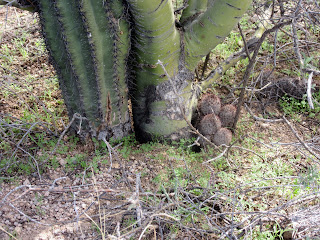"...but a dead tree may be as arresting, as filled with personality, in death as it is in life. Even in its final moments, when the massive trunk lies prone and it has moldered into a ridge covered with mosses and fungi, it arrives at a fitting and noble end. It enriches and refreshes the earth. And later, as part of other green and growing things, it rises again." - Edwin Way Teale
 |
| A downed tree in Olympic National Park. |
I love learning. The label I've learned from the library world is that I am a "
life-long learner." That is one of the reasons I find travel so compelling. There are always new birds, new plants, new accents, new foods, and more to learn and discover. On our
megavacation to the rainforest on the Olympic peninsula last fall we learned about
nurse logs. We don't have nurse logs like that out here in Montana--I suspect because it isn't moist enough. We thought they were rather fascinating.
 |
| A nurse log with saplings in Olympic National Park. |
Nurse logs are trees which fall to the ground and, as they decay, become a source of nutrient and protection for a new generation of trees (not to mention moss, fungus, etc.). The new trees actually grow right out of their fallen benefactor. As we hiked we'd find a nurse log with hundreds of saplings reaching for the sky from their perch on top--over and over again. They were everywhere.
 |
| A nurse log with saplings in Olympic National Park. |
Eventually the nurse log decays away completely, often leaving the roots of their young companions suspended in air several feet above the ground. The whole process is incredibly neat.
 |
| A tree growing in mid-air after the complete decay of its nurse log in Olympic National Park. |
 |
| A nurse stump with sapling (including the sapling's visible roots) in Olympic National Park. |
Matt and I were talking about it as we hiked--about why we'd never seen such a thing as we hiked in Yellowstone and the Beartooths. We figured that while it is entirely probable that nurse trees exist in the lush forests of NW Montana, most of our state is too arid and/or devoid of trees for nurse logs to be commonplace.
Then we realized that while nurse logs were new the phenomenon wasn't wholly unknown to us. Just different. Our first hand experience comes in the form of nurse rocks though, not trees.
 |
| A nurse rocks buttresses a tree in the Custer-Gallatin National Forest. |
Nurse rocks are often remnants of our glacial past in the form of "erratics" scattered across the land from the mountains to the plains. However they can also come to be through other processes of time and erosion. Nurse rocks create microclimates which are beneficial to plants and animals alike by extending the growing season, holding moisture, providing shade and more. One study from Glacier National Park found that 63% of trees were growing beside a rock. 63%!
Here is a cool
segment from Montana PBS (in text and audio) about nurse rocks in Montana, for anyone who wants to learn a bit more.
And then nature took our education on one step further.
 |
| A young saguaro growing up through the branches of a palo verde tree in Saguaro National Park. |
While we were
traipsing about the Sonoran Desert we learned about the
relationship between saguaro cacti and nurse trees. Young saguaros frequently make their start at the base of a tree or shrub which helps provide shade and increased moisture. Upon learning this we instantly made the correlation between this and nurse logs/rocks up north. It was marvelous to realize how dramatically different each of these landscapes are--rainforest to desert, mountains to plains--yet they're not without their similarities. I thought this was totally remarkable.
 |
| A palo verde acts as nurse to both a saguaro and pincushion cacti in Saguaro National Park. |
Nurse logs decay away and leave the next generation to their growth. Nurse rocks are sometimes cracked by their tree companions, but more commonly see them live out their days side by side. The same rock might nurse generations of trees, in fact. Saguaros usually out-compete and outgrow their shorter-lived shrubby neighbors, to the detriment of the nurse tree.
Still. It all goes to illustrate the interconnection of life, nature, the universe and all that that encompasses. Even the towering saguaro once needed a little help getting there. The tides need to moon. We need the earth. It is all so cool and connected that it boggles my mind with the integrated complexity of it all.
 |
| Matt and a superb saguaro specimen in Saguaro National Park. |
What a world we're blessed to experience! Each and every part of it has so much to show, to teach, to give.












Comments
Post a Comment
Thanks for taking the time to share your thoughts and ideas. I value the advice and friendship that you share with me!